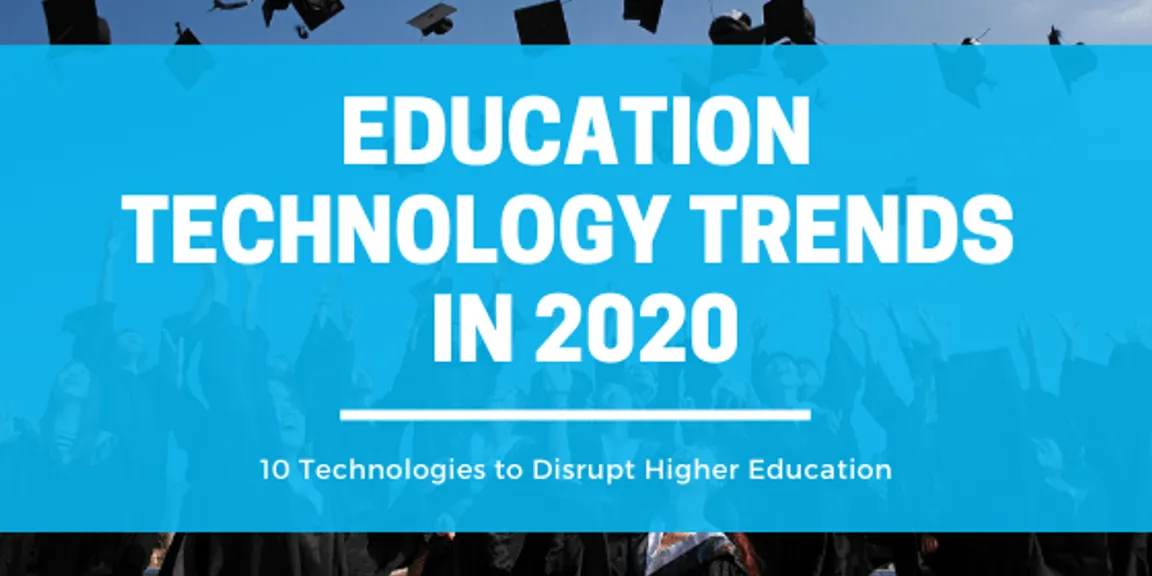

10 Education technology trends that will disrupt higher education the most in 2020
Explore how Education Technology can transform higher education in India in the year 2020 with blockchain, video-based learning, AI driven student performance analysis, advanced assessment techniques, Virtual reality-based education, etc

Higher Education across the world is on the verge of getting disrupted due to technology advancement.
Technology will play a key role in education, delivery, content distribution and the assessment of students.
Higher education institution might become outdated if they do not adopt emerging technologies and trends to teach their students. Technology can help higher education to make education dynamic, relevant and connecting with the real or practical world.
Digital spending on education is projected to be 350 billion USD+ by 2025 and growing rapidly across the world. Education is one of the under served segments which can be lifted with the help of technology adoption.
Higher education institutions would accelerate the adoption of cloud-based technologies for student relationship management (CRM), learning management systems (LMS), assessment management.
Preference would be for niche applications having seamless integration capability with other applications. If you are building EdTech applications then it become essential to have components to integrate your application with other applications.
I have compiled some of the leading things which are helping higher education institutions immensely and it is likely to dominate in the education learning process in the year 2020.
Here is the list of Technologies that would shape Higher Education in 2020
Video-Based Learning

According to the latest study by Cisco, by the end of 2019 more than 80% of the internet traffic would be driven by video consumption. The year 2020 would see more growth in internet traffic from the video.
More than 2.3 billion people are active on youtube and watching various videos for entertainment and education.
Video is becoming a de facto medium for learning purpose. Instead of reading long paragraphs, students would also prefer to watch videos for better understanding and knowledge retention process.
Penetration and new technology innovations like smart Television, Android-powered televisions are likely to increase video consumption for the users.
There are many devices connected to the internet and it is growing rapidly.
Higher education institution is likely to invest in building educational, interactive or interesting videos to make higher education learning more interesting. Video-based learning is also scalable and it can be easily used repetitively.
If you are associated with higher education institution then you need to take into consideration video preparation tools and techniques to remain relevant in the digital world. There are many instances where niche knowledge can be taught by visiting faculty. Travel and logistics become a bottleneck for such a niche teaching process.
You can easily record a series of lectures for such instances and the same can be viewed by the students. Faculty can be involved in the query resolution process.
There are various types of videos you can prepare
- Educational / Topic Based Videos
- Technology-based videos with screenshots, images along with a description
- Classroom Based Videos
There are several video preparation tools available which can certainly accelerate the video-making process. loom.com is one such free tool to prepare educational videos.
Video production and distribution or hosting online are becoming cost-effective or cheap. Many new tools are coming up for video creation, video editing. Higher education institutions should adopt a video-based learning process to keep pace with changing trends.
If you have visiting faculty coming for teaching some of the niche subjects then it would be a good idea to record the lectures so that students can refer to it at a later time.
Students can also be encouraged to enroll in online learning courses available to acquire knowledge and accelerate the learning process.
There are numerous advantages of videos as students can repeat the learning process by watching some of the videos to understand some of the concepts or even to revise the learning process.
The revision process can be managed from any device like a smartphone, computer or smart television.
Blockchain

Blockchain is technology acting as a framework for ever-growing cryptocurrency. Blockchain is providing great collaboration and secure data exchange opportunities for the organizations as well as individuals. Security protocols followed in blockchain are unique and difficult to hack.
There are a lot of case studies and use cases emerging for the usage of blockchain in the higher education sector.
Student data sharing between multiple universities for a semester exchange, course exchange, student transfer, data exchange for a scholarship with authority, student academic data sharing with companies for recruitment are some of the cases where blockchain can be useful.
The year 2020 would have more useful use cases driven for the higher education sector and it would certainly go to drive adoption of blockchain for higher education institutions. If you are looking for an early mover advantage then it is the right time to look into blockchain technology.
Digital storage of academics information and accessibility to it for authenticated users would accelerate its implementation with the help of blockchain technology.
Online Assessment Techniques

The examination process is one of the key success factors for student evaluation and overall education delivery with the evaluation process. Exams are traditionally conducted with pen and paper-based environment. Manual evaluation of answer sheets is dominant for the majority of the higher education institutions.
Online Exams are helping institutes to automate and simplify the examination and overall assessment process for students. Online assessments can help in speeding up the overall time taken for the evaluation process.
AI-driven assessments can help institutes to get a holistic analysis of student performance in a particular exam.
Using machine learning and artificial intelligence-driven algorithms, theory answers written by the students can also be evaluated by the software.
It can compare the answers with model answers for better accuracy prediction. Machine driven evaluation is likely to become the norm in the coming years starting from the year 2020.
New security techniques can help to make the online exam more secure. You can prevent cheating using techniques like remote proctoring.
In the case of the proctoring process, the system can capture photographs and videos of the candidate appearing for the online exams from remote locations. The system can also verify remote candidate using image processing techniques.
It is possible to automate the online exam invigilation process using remote proctoring process.
Self Paced Learning

Technology can drive usage of e-learning or self-paced learning. Self mode study is the essence of online learning. It can help students to study at their own pace. Many universities have come up with fully online courses and students are supposed to compulsory enroll in a couple of such courses in each semester. Entire evaluation happens using online assessments.
There is no traditional teaching involved. Students can learn at their own pace and grasp concepts with online and personalized learning methodology.
Higher education institutions are coming up with various courses and certification programs that are exclusively taught in online mode. Students can view recorded lectures, can participate in live chat with instructors and can learn from any location.
Higher education institutions are likely to invest a significant budget on online learning instead of traditional spending on building classroom-based infrastructure.
Artificial Intelligence (AI)

AI is likely to dominate a lot of headlines in the coming year. It has found millions of use cases across multiple sectors. Higher education has got many useful implementations of AI.
Facial recognition is one of the forms of AI where the institution can easily track attendance of the students based on capturing photos on each day. Facial recognition can also be helpful to secure campus infrastructure from unauthorized access.
There are many use cases in terms of exam security, identification of cheating during online exams, AI-powered auto proctoring to conduct exams without any physical invigilation.
Technology can empower to conduct exams without any physical human intervention of the traditional physical invigilation process.
AI can also help performance evaluation of the student or group of students. The entire information on student exam performance can be analyzed using various data analytics algorithms. It can provide useful insight into student performance and it can help reduce bias from the personalized feedback to the students.

Tech and data-Driven Analysis of Students

Data analysis using machine learning or analytics can be helpful for higher education. Manual evaluation or feedback mechanism based on certain subjective assessment is biased and has limitations.
Technology can help to maintain historical data of the student and accurate feedback can be shared with the students about their performance. Data-driven analysis can be helpful to eliminate bias during evaluation and student assessment process.
Such data can be useful to predict the future performance of the group of students or individual students. Such future predictability helps higher education institutions to prepare students in a better way.
Virtual Reality

Virtual Reality (VR) is becoming a cost-effective tool to experience learning rather than a passive form of learning. VR brings things in front of you as if you are standing just next to it.
Imagine a biology student who can see a 3-dimensional skeleton in front of him in the 3 D format. Students can wear glasses to see it and experience it. The entire structure of the bones can be easily learned in a quick time using VR.
VR technology is becoming cheap day by day. There are a lot of games are being developed on the concept of VR. Millennials are playing those games with great passion. Time has come to develop games focusing on education.
It would be a sort of edutainment where learning and entertainment can happen at the same time. The knowledge acquisition process can be improved drastically using VR for higher education.
Better content using VR is the need of an hour and coming year 2020 would see more innovative educational content being developed in the form of 3 dimensional VR.
Here is interesting video about Virtual Reality in Education
Virtual reality can help the understanding of the concept of education instead of reading information about it.
Internet of Things (IoT)

IoT is helping many sectors for automation and control. It is likely to be used in higher education as well. Many use cases like face detection, monitoring student vehicles, analysis of machine performance can be done using IoT.
Digital attendance management using biometric, student location tracking, the school bus can be easily managed with the help of IoT technology.
IoT devices and technology is useful to keep a tab on the usage of electricity in the campuses. IoT can detect the presence of humans in the class or absence and can switch on / off electricity/ lights accordingly.
Devices needed for IoT is also becoming cost-effective. Many industry-driven use cases are driving the need for skilled professionals in this sector.
IoT can help higher education institution to have a secure campus environment with advanced face recognition techniques
IoT can also help to track the total time taken by the students for completing a particular assignment. Assignment timing pattern can provide useful insights into overall hours put by the students for completing it and it can be compared with class performance.
Here is one of the video about how Schools can use IOT
Chatbots

Chatbots are something that is taking off since the last 12 months or so. Many new and exciting technology providers have come up with simple, intuitive workflow based chatbot development where you can easily configure the machine to chat with real humans in a live chat environment.
Chatbots can resolve queries of website, mobile app visitor on an instant basis. A chatbot can be integrated with frequently asked questions, articles, blogs of the education institution. It can help students resolve their typical queries on 24 X 7 basis.
Chatbots has several applications in a higher education institution for automation of prospective student query resolution related to scholarships, education loans, admission process, admission criteria related queries, fee-related queries. Entire human intervention can be eliminated with the help of chatbots.
As a higher education institution, you might be getting thousands of queries from prospective students about the admission process, fee-related queries. Currently, you may require resources to handle phone and email queries.
Chatbots can help to resolve those queries virtually on an instant basis. You can save a huge administration cost of resolving those queries over phone calls or emails.
Use cases and overall technology adoption for a chatbot is increasing and the coming year would see more such applications in the higher education segment.
Chatbots can simplify the following things
1. Student Query Resolution during Admission
2. Automated Enquiry Management and Resolution
3. Lead Generation for Education Courses
Podcasting

Podcasting is likely to be a new radio of Millenials. The podcasting industry is taking off and many new podcasting channels are coming up on various entities like apple, google podcasts. Many educational channels are also active on the podcast. It is becoming a new way of acquiring knowledge and learning.
Currently, the majority of the podcasts are available for free. But there is scope for a paid podcast where exclusive podcast episode would be shared with paid subscribers.
Any time Learning
Podcasting offers a great advantage as it can be downloaded on mobile devices and can listen at any time while doing multitasking activity. Typically videos or face to face lectures has attention span which is less than 2 to 3 mins for videos and 10 to 15 mins for lectures. However, in the case of podcasts, this issue is eliminated. Students can listen to information while doing other routine activities like jogging, playing, etc.
Listen to Recorded Lectures
The simplest use of podcasts for educators or teachers would just record your lectures and make it available for the students to listen at a later time. It would help resolve queries, clarify some concepts, revise study at a later time.
Benefits for Visually Impaired Students
The educational podcast is also beneficial for visually impaired students who are unable to read the books. Listening to podcasts can be the solution for it
Listening or asking students to listen to some of the educational podcasts and then having relevant discussions in the classroom can be beneficial for the creative thinking of the students. You can get to listen to some of the best educators for free through a powerful medium like podcasts.
There are many useful podcasts available at iTunes and google podcast store to learn languages like English and other languages. You can easily learn a new language on the go by subscribing to those podcasts.
Higher education institutions have not started taking podcast seriously for educational purposes.
But the coming year could see many higher education institutions start having their channel for podcasting. It can act as a brand-building tool as well as an educational tool.
Summary
Higher education institution which can quickly adapt to changing technology and would be able to implement it effectively can build a reputable brand in the higher education field.
Brands of higher education institution would be recognized due to technology implementations and traditional physical infrastructure investment may come second to technology.
Conclusion
Higher education institutions should focus on changing trends and start adapting to new technologies to make education interesting, relevant and practical. Higher education institution can improve their brand image with quick adoption of the latest trends in technology.
Step by step approach of adopting those technologies can help a long way for improving higher education integration with the industry-relevant knowledge base.




